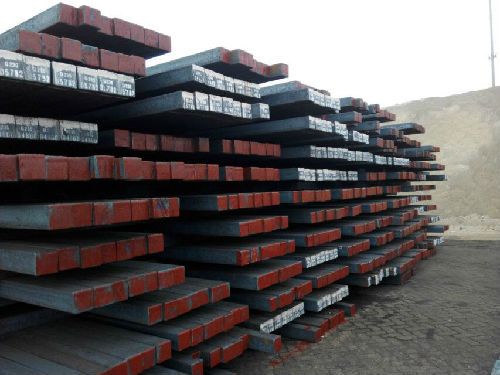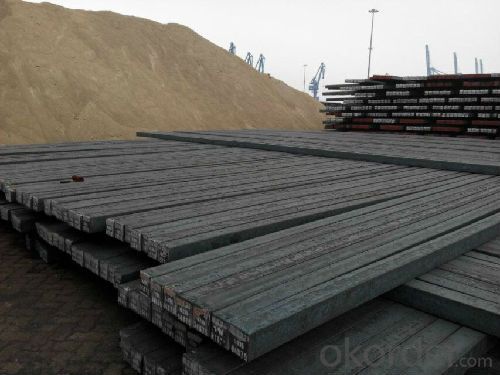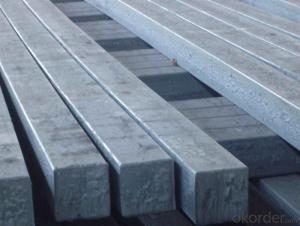Hot Rolled Steel Square Bar GB, ASTM, JIS Standard WIth High Qualty
- Loading Port:
- China main port
- Payment Terms:
- TT or LC
- Min Order Qty:
- 25 m.t.
- Supply Capability:
- 200000 m.t./month
OKorder Service Pledge
OKorder Financial Service
You Might Also Like
Product Description:
OKorder is offering Hot Rolled Steel Square Bar GB, ASTM, JIS Standard WIth High Qualty at great prices with worldwide shipping. Our supplier is a world-class manufacturer of steel, with our products utilized the world over. OKorder annually supplies products to European, North American and Asian markets. We provide quotations within 24 hours of receiving an inquiry and guarantee competitive prices.
Product Applications:
High Qualty Hot Rolled Steel Square Bar GB, ASTM, JIS Standard WIth High Qualty are ideal for structural applications and are widely used in the construction of buildings and bridges, and the manufacturing, petrochemical, and transportation industries.
Product Advantages:
OKorder's Hot Rolled Steel Square Bar GB, ASTM, JIS Standard WIth High Qualty GB, ASTM, JIS Standard are durable, strong, and resist corrosion.
Main Product Features:
· Premium quality
· Prompt delivery & seaworthy packing (30 days after receiving deposit)
· Corrosion resistance
· Can be recycled and reused
· Mill test certification
· Professional Service
· Competitive pricing
Product Description:
Specifications of High Qualty Hot Rolled Steel Square Bar GB, ASTM, JIS Standard:
-Standard: GB,
-Grade: Q195/Q235 or equivalent.
-Chemical Composition:
Standard | Grade | Element (%) | ||||
C | Mn | S | P | Si | ||
GB | Q195 | 0.06~0.12 | 0.25~0.50 | ≤0.050 | ≤0.045 | ≤0.30 |
GB | Q235B | 0.12~0.20 | 0.30~0.70 | ≤0.045 | ≤0.045 | ≤0.30 |
-Mechanical Properties:
Mechanical Properties | Grade | Steel diameter(mm) | |||
≤16 | 16~40 | 40~60 | 60~100 | ||
Yield Point Δs/MPa | Q195 | ≥195 | ≥185 | - | - |
Q235 | 235 | 225 | 215 | 205 | |
Tensile Strength | Q195 | 315~390 | |||
Q235 | 375~500 | ||||
Elongation δ5% | Q195 | ≥33 | ≥32 | - | - |
Q235 | 26 | 25 | 24 | 23 | |
Measures of High Qualty Hot Rolled Steel Square Bar GB, ASTM, JIS Standard:
-Length of a side and Theoretical weight of Square Bar (Big measures).
Length of a side(mm) | Theoretical weight(kg/m) | Length of a side(mm) | Theoretical weight(kg/m) |
53 | 22.05 | 80 | 50.24 |
56 | 24.61 | 85 | 56.72 |
60 | 28.26 | 90 | 63.59 |
63 | 31.16 | 95 | 70.85 |
70 | 38.49 | 100 | 78.50 |
75 | 44.16 |
Notes:
1, The theoretical weights in the list, base on the density of 7.85 g/cm3.
2, Formula for theoretical weight of Square bar: a(length of a side) * a * 0.00785
3, The numbers with *mean that they are not regular or we don’t offer them.
-Regular length of Square Bar:
Steel | Length of a side (mm) | Length of steel (m) |
Normal steel | < 25 | 4~10 |
> 25 | 3~9 | |
Steel of high quality | All measure | 2~6 |
Tool steel >7 | 1~6 |
Usage/Applications of High Qualty Hot Rolled Steel Square Bar GB, ASTM, JIS Standard:
-The Square Steel is normally used as structure steel.
-Row material for other structure steel like steel angles, channels, I-beams, H-beams, etc…
-Row material for steel pipes.
Packaging & Delivery of High Qualty Hot Rolled Steel Square Bar GB, ASTM, JIS Standard:
-Packing Detail:
1, The products can be packed in bundles by steel wires.
2, The weight of each bundle no exceed normally 3 tons.
-Marks: We make tag marks and color marks for each bundle. The tag marks with white background and red company log will be tied up to each bundle. The information is usually including basic information of company and products like product name, specification, etc...and other information required by customers. As for color marks, we will paint both ends of each bundles to make sure that it will be more convenient for customers to distinguish theme from other products.
-Delivery Detail: 30~45 working days after receive buyer’s T.T. or L/C.
Payment:
-Invoicing on theoretical weight or actual weight as customer’s request.
-FOB, CFR or CIF.
-Regular terms of payment:
1, 30% payment in advance, the remaining balance (70% payment) against the copy of B/L.
2, 30% payment in advance, the remaining balance (70% L/C) against the copy of B/L.
3, Negotiable.
-The payment terms will be written in contraction detailedly.
We sincerely welcome partners around the world to establish business cooperation with us on the basis of mutual trust, benefit and development.
FAQ:
Q1: Why buy Materials & Equipment from OKorder.com?
A1: All products offered byOKorder.com are carefully selected from China's most reliable manufacturing enterprises. Through its ISO certifications, OKorder.com adheres to the highest standards and a commitment to supply chain safety and customer satisfaction.
Q2: How do we guarantee the quality of our products?
A2: We have established an advanced quality management system which conducts strict quality tests at every step, from raw materials to the final product. At the same time, we provide extensive follow-up service assurances as required.
Q3: How soon can we receive the product after purchase?
A3: Within three days of placing an order, we will begin production. The specific shipping date is dependent upon international and government factors, but is typically 7 to 10 workdays.
Images:


- Q:How do you use a steel square to mark out parallel lines on irregular surfaces?
- To achieve parallel lines on irregular surfaces using a steel square, follow these instructions: 1. Ensure the steel square is thoroughly cleaned, devoid of any dirt or debris. This will aid in maintaining precise measurements. 2. Determine the two points on the irregular surface where the parallel lines should be marked. These points can be the edges of a board or any other reference points of your choosing. 3. Position the steel square on the surface, aligning one side of the square with one of the reference points. Securely hold the square in place. 4. Utilize a pencil or scribe to glide along the edge of the square, creating a line on the surface. 5. Next, align the same side of the square with the other reference point and repeat the process of marking a line. 6. By now, you will have two parallel lines marked on the irregular surface, equidistant from the reference points. 7. If additional parallel lines are required, simply repeat steps 3 to 6, aligning the square with the previously marked lines. It is important to take note that the accuracy of the parallel lines depends on the precision of your measurements and the stability of the steel square during the marking process. Additionally, exercise caution regarding any irregularities or bumps on the surface that may impact the accuracy of the lines.
- Q:Can a steel square be used for checking the alignment of beams?
- Checking the alignment of beams can be done using a steel square. Carpenters and builders commonly utilize this versatile tool for various measurements and alignments. It consists of a long metal blade and a handle that is perpendicular to it. To ensure that a beam is straight and not warped, the long blade of the square can be placed along its length. The perpendicular handle can then be used to determine if the beam is perfectly vertical or horizontal. By placing the square against the edges or surfaces of the beam, any deviations from the desired alignment can be easily detected. Consequently, a steel square proves to be a dependable and effective tool for checking beam alignment in construction projects.
- Q:How do you use a steel square to mark out parallel lines on curved surfaces?
- To use a steel square to mark out parallel lines on curved surfaces, you would first position the square on the curved surface so that one edge of the square is aligned with the desired parallel line. Then, using a pencil or marking tool, you can trace along the edge of the square to create the parallel line. Repeat this process at different points along the curve to mark out multiple parallel lines.
- Q:What are the common accessories that come with a steel square?
- The common accessories that come with a steel square typically include a protective case or sheath, an instruction manual or guide booklet, and sometimes a carpenter's pencil or marking tool.
- Q:Can a steel square be used for checking the plumbness of walls?
- Yes, a steel square can be used for checking the plumbness of walls. A steel square is a versatile tool that can be used for various measurement and marking tasks in carpentry and construction. One of its applications is checking the plumbness or vertical alignment of walls. By placing the steel square against the wall, specifically against the corner, and using a level to ensure the square is perfectly vertical, one can determine if the wall is plumb or if it is leaning either inward or outward. This method provides a quick and accurate way to assess the verticality of walls and is commonly used by professionals in the industry.
- Q:What are some common conversions and calculations that can be done with a steel square?
- A steel square, also known as a framing square or carpenter's square, is a versatile tool used in carpentry and woodworking. It consists of a long blade and a shorter tongue that meet at a right angle. Here are some common conversions and calculations that can be done with a steel square: 1. Measuring and marking: The steel square can be used to measure and mark straight lines or right angles on a piece of wood or other materials. It is particularly useful in determining 90-degree angles for accurate cuts and joint construction. 2. Determining squareness: By using the square's 90-degree angle, you can check the squareness of corners and ensure they are perfectly perpendicular. This is important for constructing frames, cabinets, and other structures. 3. Finding roof pitch: Carpenters often use a steel square to determine the pitch or slope of a roof. By placing the square on the roof surface and aligning it with the rafters, the angle of the roof pitch can be measured. 4. Calculating rafter lengths: A steel square can also be used to calculate the length of rafters for roofs. By using the square's markings and angles, carpenters can quickly determine the appropriate length of rafters needed for a specific roof design. 5. Making angle cuts: The steel square can be used to mark and guide angle cuts on wood or other materials. By aligning the square's blade or tongue with the desired angle and marking the cut line, precise angle cuts can be achieved. 6. Creating parallel lines: The square's straight edge can be used to draw parallel lines by simply sliding it along the edge of the material while keeping it aligned with the desired distance. 7. Measuring and transferring dimensions: The square can be used as a ruler or measuring device for both straight and diagonal measurements. It is useful in transferring measurements from one piece of material to another accurately. 8. Checking flatness: The steel square can also be used to check the flatness of a surface. By placing it on a flat surface and observing if the entire length is in contact, any deviations or unevenness can be detected. Overall, a steel square is a versatile tool that can be used for a wide range of conversions and calculations in carpentry and woodworking. Its ability to measure, mark, determine angles, and assist in various construction tasks makes it an essential tool for any carpenter or woodworker.
- Q:Can a steel square be used for laying out a deck?
- Indeed, a deck can be laid out using a steel square. A steel square, also referred to as a framing square or carpenter's square, is an adaptable instrument that can be utilized in a variety of construction and carpentry undertakings, including deck construction. It is commonly employed to establish and delineate right angles, measure and mark cuts, and confirm the squareness and levelness of a structure. During the process of laying out a deck, a steel square can be employed to guarantee the precise positioning and alignment of the deck's framing and support structures. It can be utilized to mark the arrangement of the deck boards, ascertain the placement of posts and beams, and verify the squareness of the deck corners. Typically, a steel square consists of two arms - a lengthy one known as the blade and a shorter one called the tongue. The blade usually measures 24 inches in length, while the tongue measures 16 inches. These dimensions are practical for deck layout since standard deck boards are often either 6 or 8 feet long. The steel square enables accurate measurements and angles to be marked, ensuring a professional and precise deck layout. In conclusion, a steel square is a dependable tool for laying out a deck as it provides the necessary accuracy and precision required for a successful and visually appealing deck construction project.
- Q:How do you use a steel square to measure and lay out a miter joint?
- Achieving a clean and professional-looking joint can be accomplished by utilizing a steel square for measuring and laying out a miter joint. Follow these steps to ensure accuracy: 1. Begin by selecting a steel square that corresponds to the measurements required for your project. A standard steel square typically consists of two arms, with one arm being shorter and the other longer, creating a 90-degree angle. 2. Place the longer arm of the square against one side of the material that will be cut, serving as the reference edge for your miter joint. 3. Align the shorter arm of the square with the edge of the material that is perpendicular to the reference edge. This alignment guarantees a precise 45-degree angle for your miter joint. 4. Once the square is accurately positioned, utilize a pencil or scribing tool to mark the desired cut line along the shorter arm of the square. 5. Repeat this process on the other piece of material that will form the miter joint. Consistently aligning the square on both pieces is crucial to ensure matching angles. 6. Once the cut lines are marked on both pieces, proceed to carefully cut along the marked lines using a suitable cutting tool, such as a saw. Take your time to guarantee a clean and accurate cut. 7. After making the cuts, test-fit the two pieces together to assess the accuracy of the miter joint. If the fit is not snug or aligned, make any necessary adjustments. 8. Once you are satisfied with the fit, secure the miter joint in place using appropriate joining methods, such as gluing, nailing, or screwing. By utilizing a steel square to measure and lay out your miter joint, you can achieve precise and accurate angles, resulting in a flawlessly executed and professional-looking joint.
- Q:Can a steel square be used for plumbing and pipefitting?
- Certainly! A steel square, which is also referred to as a carpenter's square or a framing square, possesses the versatility required for plumbing and pipefitting tasks. This tool enables the measurement and marking of angles, the assessment of squareness, and the achievement of precise cuts and joints. In the realm of plumbing and pipefitting, a steel square serves the purpose of measuring and aligning pipes, executing meticulous cuts, and ensuring the appropriate angles and squareness in fittings and connections. Additionally, it proves valuable in establishing reference points and facilitating the proper installation of pipes and fixtures. Nevertheless, it is crucial to acknowledge that for more specialized plumbing and pipefitting endeavors, alternate tools specifically tailored for those tasks may prove more suitable and accurate.
- Q:Can a steel square be used for checking the squareness of a power planer table?
- No, a steel square cannot be used for checking the squareness of a power planer table. A steel square is typically used for checking the squareness of corners or edges of materials, but it is not suitable for checking the squareness of a larger surface like a power planer table. To properly check the squareness of a power planer table, specialized tools such as precision straight edges or dial indicators are more appropriate. These tools allow for accurate measurements and ensure that the table is perfectly square, which is important for achieving precise and uniform planing results.
1. Manufacturer Overview |
|
|---|---|
| Location | |
| Year Established | |
| Annual Output Value | |
| Main Markets | |
| Company Certifications | |
2. Manufacturer Certificates |
|
|---|---|
| a) Certification Name | |
| Range | |
| Reference | |
| Validity Period | |
3. Manufacturer Capability |
|
|---|---|
| a)Trade Capacity | |
| Nearest Port | |
| Export Percentage | |
| No.of Employees in Trade Department | |
| Language Spoken: | |
| b)Factory Information | |
| Factory Size: | |
| No. of Production Lines | |
| Contract Manufacturing | |
| Product Price Range | |
Send your message to us
Hot Rolled Steel Square Bar GB, ASTM, JIS Standard WIth High Qualty
- Loading Port:
- China main port
- Payment Terms:
- TT or LC
- Min Order Qty:
- 25 m.t.
- Supply Capability:
- 200000 m.t./month
OKorder Service Pledge
OKorder Financial Service
Similar products
New products
Hot products
Related keywords


























